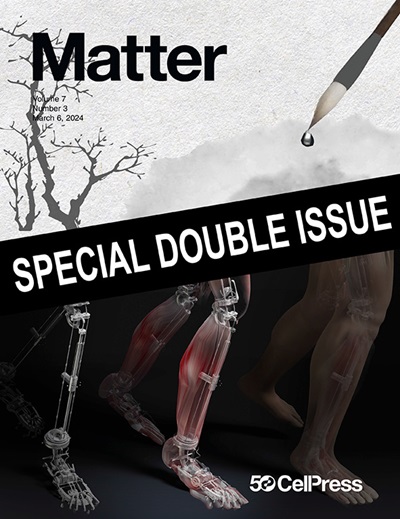Sustainable conversion of husk into viscoelastic hydrogels for value-added biomedical applications
IF 17.3
1区 材料科学
Q1 MATERIALS SCIENCE, MULTIDISCIPLINARY
引用次数: 0
Abstract
Natural plants provide a wealth of valuable materials for healthcare, with much of their potential often overlooked in what is commonly considered waste. This study focuses on the Malva nut tree (Sterculia lychnophora Hance), whose fruit, Pangdahai (PDH), has long been used in traditional Chinese medicine. By investigating the swelling behavior of PDH husk, we efficiently extracted its polysaccharides without harsh chemicals. Using micro-compression, we developed a viscoelastic hydrogel, and through electrostatic crosslinking with chitosan, we further enhanced its mechanical properties. The hydrogel exhibited biocompatibility and accelerated wound healing by promoting keratinocyte migration. Additionally, it outperformed commercial patches as a skin-attached interfacial material for electrocardiography (ECG), demonstrating superior signal-to-noise ratios. Integrated into a 16-channel mesh electronic device, the hydrogel provided stable performance for in vivo epicardial ECG recording on a beating heart. This research highlights the potential of rigid polysaccharide waste, presenting a sustainable approach to converting plant waste into valuable healthcare materials.


可持续性地将谷壳转化为粘弹性水凝胶,用于增值生物医学应用
天然植物为医疗保健提供了丰富的有价值的材料,它们的许多潜力往往被忽视,通常被认为是废物。本研究的重点是马尔瓦坚果树(Sterculia lychnophora Hance),其果实Pangdahai (PDH)长期用于中药。通过研究PDH壳的溶胀行为,在不使用刺激性化学物质的情况下,有效地提取了其多糖。采用微压缩法制备了粘弹性水凝胶,并通过与壳聚糖的静电交联进一步提高了其力学性能。水凝胶表现出生物相容性,并通过促进角质细胞迁移来加速伤口愈合。此外,作为心电图(ECG)的皮肤附着界面材料,它表现出优越的信噪比,优于商业贴片。水凝胶集成到一个16通道网状电子设备中,为在体内记录跳动的心脏心外膜心电图提供了稳定的性能。这项研究强调了刚性多糖废物的潜力,提出了一种将植物废物转化为有价值的保健材料的可持续方法。
本文章由计算机程序翻译,如有差异,请以英文原文为准。
求助全文
约1分钟内获得全文
求助全文
来源期刊

Matter
MATERIALS SCIENCE, MULTIDISCIPLINARY-
CiteScore
26.30
自引率
2.60%
发文量
367
期刊介绍:
Matter, a monthly journal affiliated with Cell, spans the broad field of materials science from nano to macro levels,covering fundamentals to applications. Embracing groundbreaking technologies,it includes full-length research articles,reviews, perspectives,previews, opinions, personnel stories, and general editorial content.
Matter aims to be the primary resource for researchers in academia and industry, inspiring the next generation of materials scientists.
 求助内容:
求助内容: 应助结果提醒方式:
应助结果提醒方式:


